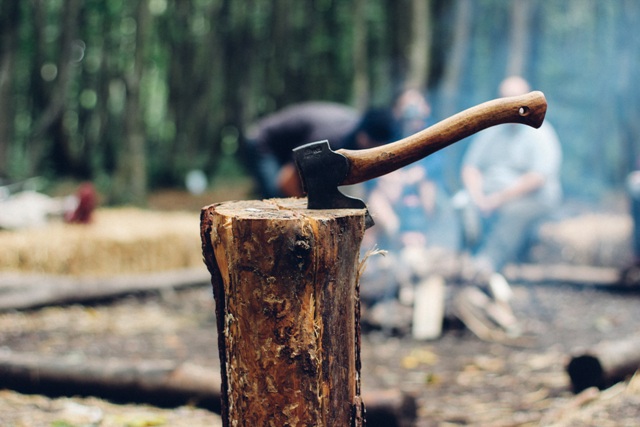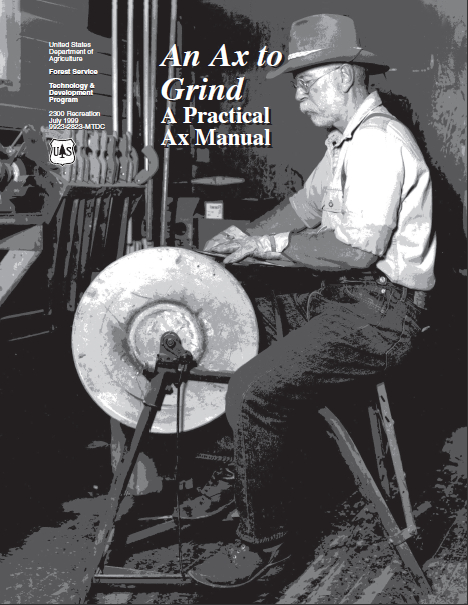
My Lack of Axe-perience
In 1973 the OPEC oil embargo caused fuel shortages and sky-high prices throughout the United States. Like many families, my parents supplemented our heating oil with a wood burning stove. My father, a schoolteacher, found a source of free wood. He eagerly felled, bucked, and carted it away to our suburban New York home.
As a child I was mesmerized watching my father split the wood in our backyard. I pressed my nose against the cold glass of the back window to watch him.
He used a makeshift chopping block, a wide section of trunk cut from a fallen tree. He was wearing too little clothing for the cold fall day: Jeans, a white undershirt, and a pair of those craggy denim and suede work gloves that make your hands itch the moment you put them on.
The rise and fall of the axe kept him warm. I guess it proves the old adage:
Firewood warms you three times: once when you cut it, once when you carry it, and once when you burn it.
My brother and I were not permitted outside when Dad was splitting wood. It’s not that we would be underfoot. Dad trusted us. There was another reason.
My father was blind.
Dad lost his eyesight years before I was born. It never stopped him from having his career or family. But imagine using an axe to split wood with your eyes closed! It’s dangerous enough without two young children running about. In retrospect, I’m astonished he did it. I would never dream of using my axe with my eyes closed!
Imagine using an axe to split wood with your eyes closed!
In later years he switched to an apparatus that had vertical rails that guided a wedge he struck with a sledge hammer. Later still, he rented a hydraulic log splitter.
So I never learned to use our family’s axe. By the time I was old enough to learn, we had the log splitter. Years went by before I encountered another axe. This time, in the context of bushcraft!
Axe Background
The axe is the most important of the basic bush tools. Outside of fire, little else can contribute more to living comfortably in the wilderness than knowing how to properly use a well-chosen axe.
– Mors Kochanski, Bushcraft: Outdoor Skills and Wilderness Survival
The axe is one of mans’ oldest tools. Hand axes found in Kenya were created almost 1.8 million years ago by Homo erectus, an ancestor of modern humans. In western Australia, modern humans created the world’s oldest known ground-edge stone axe between 45,000 to 49,000 years ago. There is little doubt that early civilization was built with the axe.
Axes remain useful today in the temperate and boreal forest. Here’s what you can do with an axe.
- Felling – Chopping down a standing tree
- Limbing – Removing the limbs from a (usually fallen) tree
- Bucking – Chopping the tree into sections
- Splitting – Cleaving the wood along the grain
- Hewing – Shaping a log by removing unwanted wood

Photo by Dan Edwards, unsplash.com, cc.0
Most people today don’t know how to use an axe. But ironically, axe terminology is part of our everyday language.
- Have an axe to grind – To have a grievance with someone where one feels the need to seek revenge. Or, to have a selfish reason or strong opinion that influences your actions.
- Get the hang of… – To succeed in learning how to do something after practicing it. This refers to mounting (hanging) an axe head correctly on the handle.
So what reputable resources exist for you to learn how to use your axe properly?
Good Axe Technique is no Axe-ident!
Below is a PDF you can download called, An Ax to Grind – A Practical Ax Manual. It was written in 1999 by Bernie Weisgerber for the Department of Agriculture Forest Service. The book provides a brief history of the axe, a guide for how to hang an axe head, a tutorial for how to use an axe, and a guide for where to buy one in the United States.
I really appreciate the “Using Axes” section. I’m always on the lookout for tips on using my axe.
Click on the link below to download this free PDF. Enjoy!
PDF download: An Ax to Grind – A Practical Ax Manual (11.4 MB)
Axe Instructional Resources
Here are some books I like that discuss axecraft and axe technique (affiliate links to Amazon).
Bushcraft: Outdoor Skills and Wilderness Survival, p. 71 – 108, Mors Kochanski
Ray Mears Essential Bushcraft, p. 40 – 49, Ray Mears
Out on the Land: Bushcraft Skills from the Northern Forest, p. 116 – 120, Ray Mears
I also like this video from Ray Mears. It’s from his Bushcraft Survival (Series Two) DVD collection. Mr. Mears is a highly respected bushcraft instructor. He discusses axes used for bushcraft and how to use them safely.
Like any tool, the secret is to practice. Read as much as you can and take prudent safety precautions. Follow the guidelines about not using your axe in the dark or when you’re fatigued.
Let me know in the comments below how you practice your axe-work.
Related Articles on NatureOutside
Bushcraft Knife Safety – 9 Tips to Avoid Accidents
Use Your Knife – Make a Whimmy Diddle Bushcraft Toy (Video)
Bushcraft Knife Skills – Practice with the Masters (Video)
For fun facts and useful tips, join the free Bushcraft Newsletter.




Leave a Comment